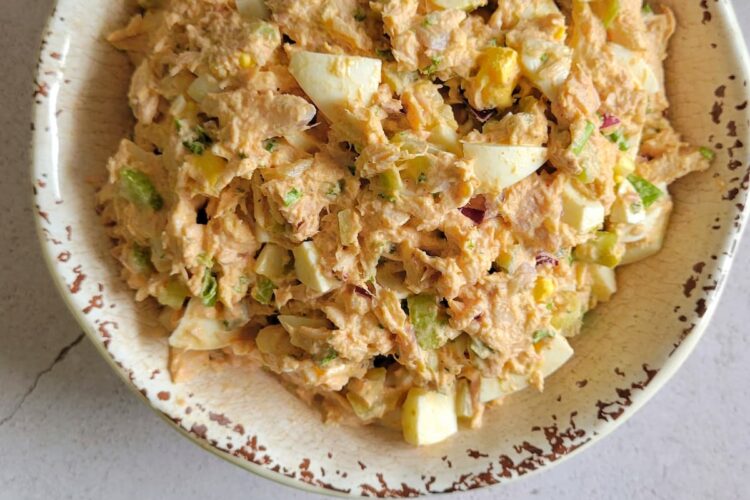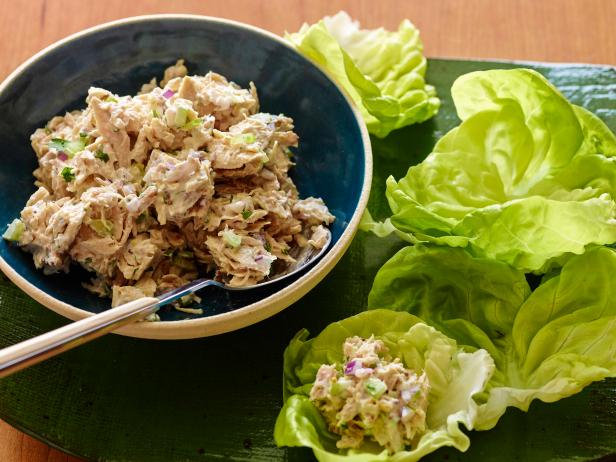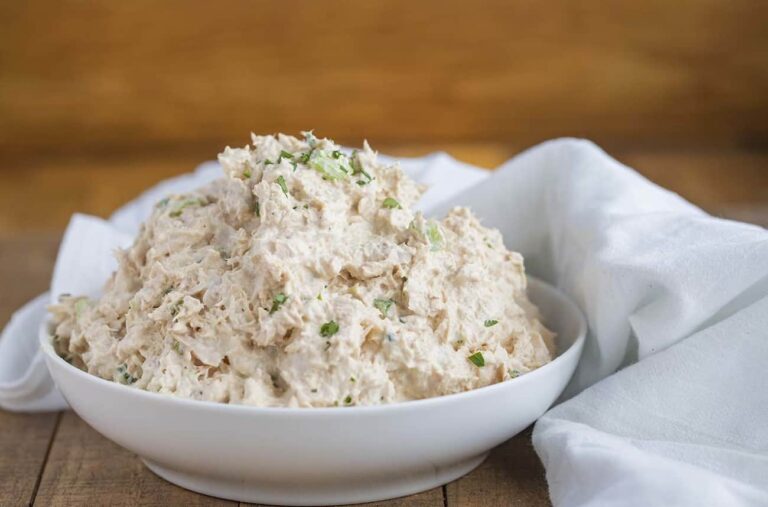Tuna salad with mayonnaise can typically be stored in the fridge for about 3 to 5 days. However, food safety guidelines recommend consuming perishable items like this within 3 days to ensure their freshness and safety.
To extend the shelf life of your tuna mayo salad, make sure to store it in an airtight container in your fridge at or below 40°F (4°C). If you notice any unusual odors, texture, or color changes, it’s best to discard them to avoid the risk of foodborne illness.
Shelf Life of Tuna Mayo

The typical shelf life of tuna mayo in the fridge (3 to 5 days)
The typical shelf life of tuna mayo in the fridge is generally between 3 to 5 days.
This timeframe is a rough estimate and can vary based on several factors, including the preparation methods, storage conditions, and the freshness of the ingredients used.
Tuna mayo is a combination of canned or fresh tuna and mayonnaise, and both of these ingredients can spoil if not stored properly.
Canned tuna typically has a long shelf life and is generally safe to consume for several years if it can remain unopened and undamaged.
However, once the can is opened and the tuna is mixed with mayonnaise or other ingredients, it becomes more perishable.
The mayo in the mix can also shorten the shelf life, as mayonnaise can spoil relatively quickly when exposed to temperature variations and contamination.
To keep your tuna mayo fresh for an extended duration, make sure to store it in an airtight container to shield it from air exposure.
Place this sealed container in your refrigerator, keeping the temperature at or below 40°F (4°C). This practice will effectively maintain the quality and shelf life of your tuna mayo, ensuring it stays safe and enjoyable for your use.
It’s also important to ensure that all utensils and hands used during preparation are clean and contamination-free.
If you have any concerns about the freshness of the ingredients or if you detect any signs of spoilage, like an unusual smell, color changes, or ingredient separation, it’s safest to be cautious and dispose of the tuna mayo.
Explain that following food safety guidelines is essential.
Following food safety guidelines is absolutely essential when dealing with perishable food items like tuna mayo.
Cleanliness: Wash your hands, utensils, and work surfaces thoroughly before handling food. This helps prevent cross-contamination.
Temperature: Store tuna mayo in the refrigerator at or below 40°F (4°C) to slow down the growth of bacteria. Especially in warmer weather, refrain from leaving it at room temperature for prolonged periods, as temperatures above 40°F (4°C) can risk food safety.
Use-by Dates: Pay attention to the expiration dates on the ingredients, especially if you’re using fresh mayonnaise or other perishable components. Always check the “use-by” or “best-by” dates and adhere to them.
Storage: Use airtight containers to store tuna mayo, which helps keep it fresh and prevents the absorption of odors from other foods in the fridge.
Visual and Sensory Inspection: Regularly check the appearance, smell, and texture of your tuna mayo. If it looks or smells off, or if you notice any separation or unusual changes, discard it.
Avoid Double-Dipping: Don’t use the same utensils or fingers to serve the tuna mayo, and then dip them back into the container, as this can introduce contaminants.
Food Safety Guidelines
Recommended Temperature for Fridge Storage:
Storing perishable foods, such as tuna mayo, in the refrigerator at or below 40°F (4°C) is of utmost importance.
This temperature range, often referred to as the “safe zone,” helps prevent the proliferation of harmful bacteria that can lead to foodborne illnesses.
Maintaining this temperature ensures that your food stays fresh and safe to eat for a longer period. Your refrigerator should have a built-in thermometer to help you monitor and adjust the temperature as needed.
Significance of Airtight Containers for Storage:
Using airtight containers for storing tuna mayo is highly significant for several reasons:
Prevents Contamination: Airtight containers create a barrier that helps keep out contaminants such as bacteria, molds, and odors from other foods in the refrigerator. This reduces the risk of spoilage and foodborne illness.
Maintains Freshness: Airtight seals minimize exposure to air, which can cause food to deteriorate more quickly. It helps preserve the quality and flavor of the tuna mayo, preventing it from drying out or becoming watery.
Reduces Oxidation: Airtight containers also limit the tuna mayo’s exposure to oxygen, which can lead to oxidation and changes in flavor and color.
Easy Identification: Transparent airtight containers allow you to easily see the contents and expiration dates, helping you quickly identify and discard any items that have gone bad.
When using airtight containers, ensure that they are clean and in good condition with secure seals to maximize their effectiveness in preserving your tuna mayo.
Importance of Proper Hygiene When Handling Tuna Mayo:
Proper hygiene when handling tuna mayo and other food items is paramount to ensure food safety. Here are some key points to consider:
Handwashing: Always wash your hands thoroughly with soap and warm water before handling food. This helps prevent the transfer of harmful bacteria from your hands to the food.
Clean Utensils and Surfaces: Ensure that all utensils, cutting boards, and countertops used during food preparation are clean and sanitized.
Use Clean and Safe Ingredients: To ensure the quality of your ingredients, particularly canned or fresh tuna, always inspect them for signs of spoilage or damage before use.
Avoid Cross-Contamination: Be mindful of cross-contamination by not using the same utensils or hands for handling different ingredients without proper cleaning in between.
For example, if you use a knife to cut raw vegetables, wash it before using it to mix the tuna mayo.
Refrigeration: Store prepared tuna mayo in the refrigerator promptly after making it, and do not leave it out at room temperature for extended periods.
Regular Inspection: Periodically check the tuna mayo for any visual or sensory signs of spoilage, and discard it if you have any doubts about its safety.
Signs of Spoilage
Common Indicators of Spoilage:
Recognizing the signs of spoilage in food, including tuna mayo, is essential for ensuring food safety. Here are some common indicators of spoilage to watch for:
- Unusual Odor: A noticeable and off-putting smell that is different from the fresh, normal scent of the ingredients. Spoiled tuna mayo may emit a sour or rancid odor.
- Changes in Texture: If the texture of the tuna mayo has become slimy, curdled, or separated, it’s a sign of spoilage. Normal tuna mayo should have a smooth and creamy texture.
- Discoloration: Any significant change in color can be a red flag. Tuna mayo that has turned brown, gray, or green or has visible mold growth should not be consumed.
- Off-Taste: If the taste of the tuna mayo is different from what you’d expect, with a sour or bitter flavor, it’s likely spoiled.
- Bubbling or Gas Production: If you notice bubbles or excessive gas production in the container, it can indicate bacterial activity and spoilage.
Importance of Recognizing Signs of Spoilage for Safety:
Recognizing these signs of spoilage is crucial for several reasons:
Food Safety: Consuming spoiled food, including tuna mayo, can lead to foodborne illnesses. Spoiled food may contain harmful bacteria, molds, or toxins that can make you sick.
Quality and Taste: Spoiled food often has an unpleasant taste and texture. Recognizing spoilage allows you to maintain the quality and flavor of your dishes and avoid a disappointing culinary experience.
Preventing Food Waste: Spotting spoilage prevents you from using spoiled ingredients in your recipes, reducing food waste and sav
ing you money.
Avoiding Cross-Contamination: Recognizing spoilage also helps prevent cross-contamination. If you identify one component of your dish as spoiled, you can avoid using it in other dishes and contaminating other ingredients.
How to Maximize Tuna Mayo Freshness?

Tips for Extending Tuna Mayo Freshness:
- Store Properly:
- For optimal freshness, keep your tuna mayo salad in an airtight container in the fridge at or below 40°F (4°C). This prevents bacterial growth and preserves the ingredient quality.
- Use Fresh Ingredients: Start with fresh ingredients when making your tuna mayo salad, including canned or fresh tuna, mayonnaise, and any other components.
Using fresh ingredients from the beginning will give you a head start in preserving freshness.
- Separate Ingredients: If possible, store the components of your tuna mayo salad separately and mix them just before serving. This can help prevent the ingredients from becoming soggy or losing their texture.
- Lemon Juice:
- Enhancing your tuna mayo salad with a touch of lemon juice not only boosts the flavor but also extends its freshness. Lemon juice contains natural preservatives that can inhibit the oxidation of ingredients like avocado or apples, helping them stay fresh for longer.
- Keep Moisture Out: Moisture can lead to the deterioration of the salad. Ensure that the salad components are properly drained and pat them dry before mixing them with the mayo.
- Portion Control: If you expect to have leftovers, only take out the portion you plan to consume. Keeping the remainder in the fridge reduces the risk of spoilage.
Creative Ways to Use Leftover Tuna Mayo:
- Tuna Melt Sandwich: Spread leftover tuna mayo between slices of bread, add some cheese, and toast it for a delicious tuna melt sandwich.
- Tuna Mayo Stuffed Peppers: Use leftover tuna mayo as a filling for bell peppers, then bake them until the peppers are tender. It’s a great way to create a new dish with your leftovers.
- Tuna Mayo Wrap: Make a wrap by filling a tortilla with leftover tuna mayo, fresh vegetables, and greens. Roll it up for a quick and satisfying meal.
- Tuna Pasta Salad: Mix leftover tuna mayo with cooked pasta, chopped vegetables, and a little extra dressing for a refreshing pasta salad.
- Tuna Mayo Dip: Turn your leftover tuna mayo into a dip by adding some Greek yogurt or sour cream for a creamy texture. Serve it with vegetable sticks, crackers, or chips.
- Tuna Mayo Sushi: Use your leftover tuna mayo as a filling for homemade sushi rolls. Combine it with avocado, cucumber, and rice, and wrap it in seaweed sheets.
- Tuna Stuffed Tomatoes: Scoop out the insides of tomatoes and stuff them with leftover tuna mayo for a tasty and healthy side dish.
- Tuna Salad Lettuce Cups: Use large lettuce leaves as cups to hold a mixture of leftover tuna mayo and diced vegetables, creating a low-carb and refreshing meal.
These creative ideas allow you to repurpose your leftover tuna mayo in exciting ways, reducing food waste and keeping your meals interesting.
Just ensure that you follow food safety guidelines when working with leftovers and that you store them properly to maintain their freshness.
FAQs
How long can I keep tuna mayo in the fridge?
You can store tuna mayo in the fridge for about 3 to 5 days, but it’s best to consume it within 3 days for optimal freshness.
Can I extend the shelf life of tuna mayo in the fridge?
Yes, you can maximize freshness by storing it in an airtight container and ensuring it’s kept at or below 40°F (4°C).
What happens if I exceed the recommended storage time?
If you go beyond the recommended storage time, the tuna mayo may become unsafe to eat due to bacterial growth, so it’s best to err on the side of caution.
How should I store tuna mayo to keep it fresh?
Store tuna mayo in an airtight container and maintain a consistent refrigerator temperature to prevent it from spoiling.
What are the signs of spoiled tuna mayo?
Signs of spoilage include an unusual odor, changes in texture (e.g., sliminess), and discoloration. If you notice any of these, it’s best to discard it.
Is it safe to freeze tuna mayo for longer storage?
While it’s technically possible, freezing may alter the texture of mayonnaise, so it’s not recommended for quality reasons.
Can I use homemade or store-bought mayo for tuna mayo?
You can use homemade or store-bought mayonnaise for tuna mayo, depending on your preference. Just ensure it’s stored and handled properly.
Should I refrigerate canned tuna before making tuna mayo?
Yes, it’s advisable to refrigerate canned tuna before making tuna mayo to maintain its freshness and food safety.
Are there any food safety risks associated with tuna mayo?
Yes, Tuna mayo can be at risk of bacterial contamination if not stored and handled correctly, so following food safety guidelines is essential.
Can I reheat tuna mayo to make it safe to eat after a few days?
It’s not recommended to reheat tuna mayo, as the mayonnaise can break down, and the texture may become unpleasant. It’s better to consume it cold.
What are some creative ways to use leftover tuna mayo?
You can use leftover tuna mayo in sandwiches, wraps, salads, or as a dip for fresh vegetables. It’s a versatile ingredient for various dishes.
Conclusion
In conclusion, ensuring the freshness and safety of your tuna mayo salad is not only a matter of good taste but also a fundamental aspect of food safety.
Storing tuna mayo properly in the refrigerator, using fresh ingredients, and recognizing signs of spoilage are key to extending its shelf life and avoiding potential health risks.
Whether you’re savoring the freshness of your tuna mayo salad or repurposing leftovers in innovative ways, remember that proper storage and attention to food safety play a vital role in your overall dining experience.

